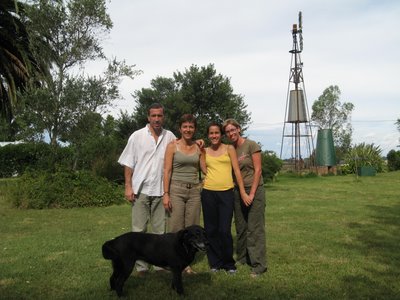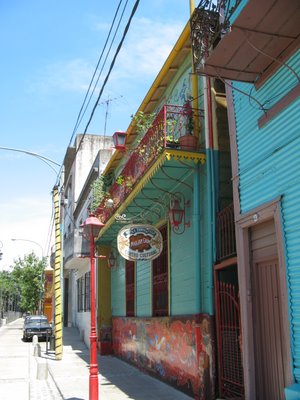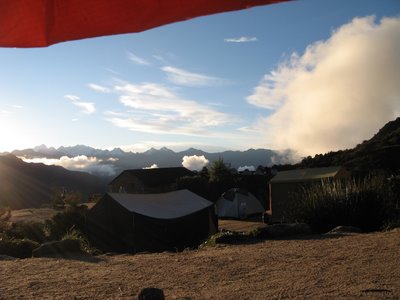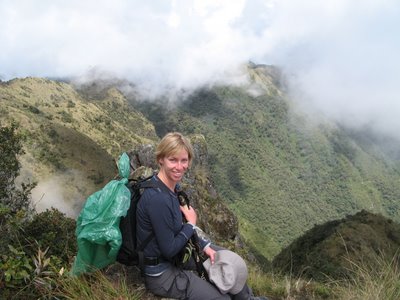Where did we spend Christmas?
In Los Glaciares National Park, Patagonia. The park is vast, 40% covered in ice fields from which 13 major glaciers descend into two great lakes, Lago Argentino and Largo Viedma. The town of El Calafate is on the shore of Lago Argetino and is the gateway town to Los Glaciares. From El Calafate we took a day long extension to Glaciar Perito Moreno, one of the few glaciers in the world still advancing. Its 5km frontage is 60 meters in height above the water line of the lake. A series of walkways allow you a close view of the glacier frontage, and it was only a matter of minutes before we heard a thunderous crack and ice splintered from the glacier hitting the lake. The glacier is intensely blue in places, (where the ice is most compacted), and the lake water an amazing shade caused by glacier milk (minerals ground into the water by the glacier, sitting in suspension). I stood open mouthed. To see a glacier at its work, carving through the mountains was an awesome sight.


Above: Perito Mereno glacier
We crossed the lake, walked alongside the glacier for an hour or so, fixed crampons to our boots and set off for our trek. Walking like stiff baby ducks, we traversed icy peaks, absailed, climbed inside ice caves (for a very quick look in my case), lunched by a glacier lagoon and stood nervously on the edge of eternal drains (giant holes leading from glacier surface, 160 meters down - you don't want to fall in there). In true Patagonia fashion, we experienced bright sunshine through to snow storms during our 6 hour trek. It was a fantastic experience, a little scary at times. I was glad to get the whisky (on the rocks - glacier ice of course) down me at the end of our adventure and enjoyed a long warm shower - brrrrrrrrrrrrrrrr.


We transferred by bus to El Chalten, a tiny new town, at the north of Los glaciares Park. Our 9 hour trek on Christmas eve, to Laguna de Los Tres, the base of Mount Fitzroy, was quite stunning. We were very lucky with the weather as the day remained fairly clear and we had a great view of the full Fitzroy range during our lunch stop. On Christmas eve we dined in a fantastic little restaurant and ate our way through a delicious five course dinner.


Above: On the way to Laguna de Los Tres and views of Fitzroy range
On Christmas Day, after Adam had settled down following receipt of his Birthday penguin book mark, we headed to Laguna Torre. Our guide seemed a little quiet and it wasn't until our first incline that he excused himself, muttering, `too much lamb` and was quite unwell. I am sure that it had nothing to do with what he was washed it down with. I felt very bad for him. Adam had absolutely no sympathy, saying no one cared when he was at work voming through a hangover. Fair point I suppose. We walked through a tree filled glacier valley and were knocked sideways by the breeze as we reached the Laguna Torre. That evening we enjoyed a hearty dinner, washed down by Chrimbo champers and fell into bed by 10pm. Lovely Christmas. As good as it can be without our friends and family.


Above: Enjoying a rest at the end of our Christmas Day walk
On Boxing Day, we traveled back to El Calafate and spent a night in a lovely hotel overlooking Lago Argentino. Happy Birthday to me, Happy Birthday to me, ohhhh, I mean Adam. Hee hee. (Where is that budget sheet - eeeeeeeeeeekkkk, maybe home sooner than we thought at this rate. Made up for our extravagance by stealing food from breakfast buffet.
From La China, to Buenos Aires to Puerto Madryn
Following our relaxing days on the farm, we traveled to Puerto Madryn and Pennisular Valdes. We were in Puerto Madryn for five days and enjoyed its long sweeping beach. We took a day long excursion to the peninsula. The wind swept landscape is baron (trees unable to grow) but rich with wildlife. A three hour boat trip rewarded us with a very close encounter with four Southern Right whales, mothers with their babies. They were in the shallows enjoying the warm waters, before their migration South. Right whales were so named because whalers thought they were the "right" whale to hunt. 40% of a right whale's body weight is blubber, which is of relatively low density. Consequently, unlike many other species of whale, deceased right whales float. Combined with the right whale's slowness through water they were easy to catch even for whalers equipped only with wooden boats and hand-held harpoons.
We visited an elephant seal colony and sat alongside for 45 minutes as they basked in the  sun. The elephant seals are the largest of their species. Their favorite food is giant squid. They, along with Sperm whales, dive up to 1,000 meters for this delicacy.
sun. The elephant seals are the largest of their species. Their favorite food is giant squid. They, along with Sperm whales, dive up to 1,000 meters for this delicacy.
From Puerto Madryn we took a further trip to Punta Tombo and the Magellanic penguin colony. Penguins as far as you could see, plenty of babies, the result of 175,000 breeding couples that occupy the colony. Shame about the tourists!! 


































